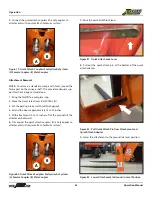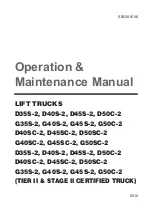
Operation Manual
65
Operation
•
Adjust the load as necessary, especially for nonstandard
loads.
•
Use caution when handling loose material that can fall
into the cab.
•
Remove overhanging load materials, when possible,
and watch for sliding material.
•
DO NOT reach a load over posts or other objects that
can enter the cab, if tipped.
•
Avoid sudden stops, starts, or turns.
•
Avoid carrying a swinging load. If necessary, secure
the load by attaching it to the forklift tie-downs and/
or have another person assist with safely steadying the
load.
Avoid carrying a suspended load. If necessary,
secure the load by attaching it to the forklift
tie-downs and/or have another person assist
with safely steadying the load. The handling
of suspended loads can introduce dynamic
forces drastically affecting the stability of the forklift.
Grades and sudden starts, stops, and turns can cause the
load to swing and create a hazard if not stabilized. Swinging
loads can become unstable, and could cause death, serious
injury, or property damage.
Suspended Loads
There is boom lift point on the underside of the boom that
may be used to lift and carry loads.
There is a dedicated boom lift point load chart on the forklift,
which should be referenced when using the boom lift
point. Refer to the suspended loads section of this manual
when handling suspended loads for specific warnings and
instructions unique to this type of operation.
Boom Lift Point
Warning
DO NOT exceed rated capacities. Any attempt
to lift or carry loads in excess of those shown
on the load capacity charts could cause
forklift tip over, loss of load, or structural
damage which could result in death, serious
injury, or property damage.
Figure 85. Boom Lift Point
1.
Do not exceed the load capacity of the forklift (as noted on
the load chart).
2.
Only lift the load vertically, and never drag it horizontally.
3.
Transport the load with the bottom of the load and the
boom as low as possible.
4.
With the load elevated, move the forklift slowly and
cautiously. Only move the forklift to the extent needed to
raise, transport, and place the load.
5.
Use guy lines to restrain load swing if possible.
Pick Up A Load
1.
Use correct load chart to review the rated load capacity of
the auxiliary attachment being used. NEVER exceed specified
weights and load centers.
2.
Approach the load slowly and squarely with the fork tips
straight and level.
3.
Adjust the spacing of the forks so they engage the pallet
or load at its maximum width. NEVER use just one fork to lift
a load.
4.
Tilt the attachment forward so the forks hang freely on the
fork shaft.
5.
Insert forks under the load until the load is against the fork
frame.
6.
Tilt the forks back, and raise the boom slightly to secure
the load.











































